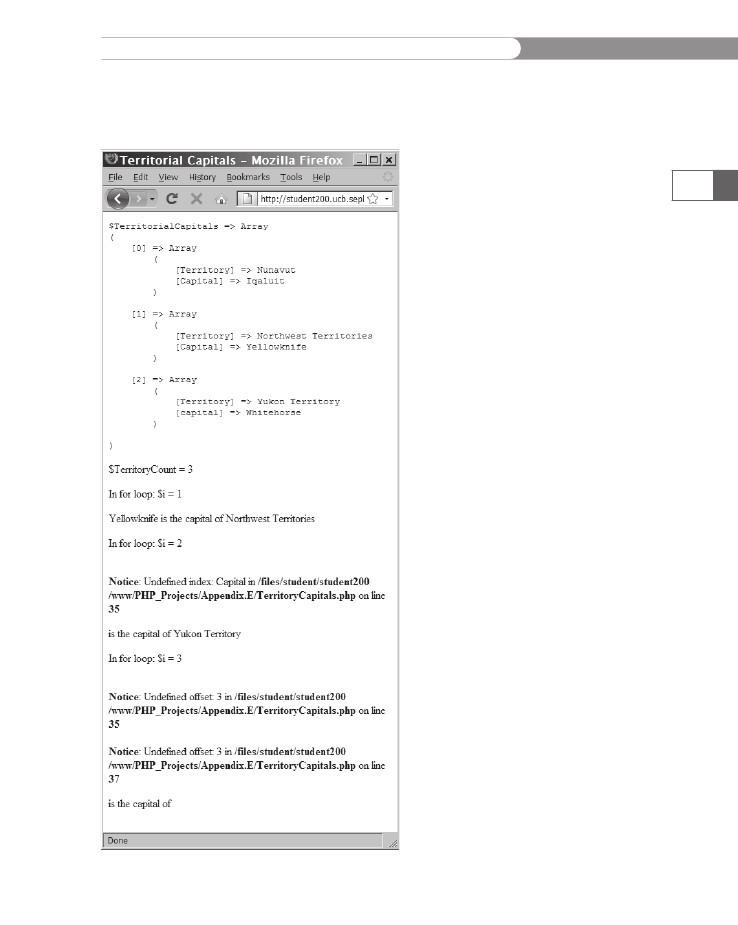
- •Initializing with Constructor Functions . . . . .
- •Into a Web page as a separate section. Although JavaScript code can
- •Is that standard php script delimiters are guaranteed to be available
- •In the block. Any text or lines between the opening /* characters and
- •2.7541 Are not integers; they are floating-point numbers. A floating-
- •Value 300
- •Is a value of 2.5, because 6 goes into 15 exactly 2.5 times. But if you
- •IsEven.Php.
- •Ing example,
- •Ing curly brace is on its own line following the function statements.
- •In php 3 and earlier, it was necessary to put a function definition
- •Is called an iteration. When the conditional expression evaluates
- •Including Files
- •13. Close your Web browser window.
- •Including Files
- •In php, you can also use two operators to combine strings. The first
- •Xhtml source code gen-
- •Input. Php provides several functions for manipulating the case of a
- •Is uppercase. If you need the reverse of ucfirst(), the lcfirst()
- •In some situations, you will need to find and extract characters and
- •Information Interchange, or ascii, which are numeric represen-
- •In comparison, the following preg_match() function returns a value
- •In the pattern is optional. The following code demonstrates how to
- •Values; any strings you validate against a regular expression must
- •Value of 1 because the top-level domain contains a valid value of .Com.
- •Is submitted using the “post” method, the form data is embedded in
- •Validating String Data
- •Xhtml tags or character entities. The message field is a text string
- •Value of the header element. For example:
- •Xhtml code within a php script section.
- •Is typically the person who created the resource. Otherwise, the net-
- •If even a single character of the Web page is sent prior to sending
- •Variables to the file_put_contents() function.
- •Xhtml hyperlink. To download a file from outside the xhtml
- •If...Else statement to display the appropriate version of the mes-
- •Iterating Through an Array
- •Iterating Through an Array
- •In Chapter 2, you learned how to use a foreach statement to iterate
- •Iterating Through an Array
- •Iterating Through an Array
- •In comparison, the following code declares and initializes
- •If ((!file_exists("MessageBoard/messages.Txt"))
- •Values from the array to create a thumbnail gallery of images in which
- •Introduction to Databases
- •Including php, allow you to create Web pages that can read and write
- •Introduction to Databases
- •Information that can be organized into ordered sets of data, and
- •Information. Each recipe in a recipe database, for instance, is a single
- •Introduction to Databases
- •Index, which identifies records in a database to make retrievals and
- •In a single table. However, you might want to break the information
- •Into multiple tables to better organize it into logical sets. Another
- •Information in one of the tables confidential and accessible only by
- •Is the employee information table from Figure 7-1. The related table
- •Is a payroll table that contains confidential salary and compensation
- •Information. Notice that each table contains an identical number of
- •Introduction to Databases
- •Introduction to Databases
- •In a junction
- •Introduction to Databases
- •In a relational format is called a relational database management
- •Is a standard data manipulation language among many dbmSs.
- •Into the query area at the top of the screen or by dragging tables and
- •It is important to understand that even though many dbmSs sup-
- •Introduction to Databases
- •If you ever
- •Is. In comparison, the bigint data type stores integer values between
- •5 Rows in set (0.00 sec)
- •Int);[enter ]
- •Important, these two tabs can cause you to lose all of the data in the
- •Internet Explorer to export the table, click the Save button in the File
- •Ifies the table being changed and the change to make.
- •It easier for you to write php code that can be used with a variety of
- •Information about queries that match one of the following formats:
- •Various types of actions, depending on the type of query.
- •Include fields for the date and time of the flight, flight number, and
- •In the ChineseZodiac folder and upload the file to the server. Open
- •Including white space,
- •Information on a Web server. When you start a new session, the
- •Introduction to Object-Oriented Programming
- •Introduction to Object-Oriented
- •Variables associated with an object are called properties or attributes.
- •In the Loan object example, a function that calculates the number of
- •Introduction to Object-Oriented Programming
- •Introduction to Object-Oriented Programming
- •Include instances of objects inherit the object’s functionality.
- •In this chapter, you will create the Web site for an online order form
- •In an online store application. The application includes information
- •Ity of building a working online store. Online store classes are very
- •Information and products. The OnlineStore class requires that store
- •Information is stored in a table containing six fields: storeId, name,
- •Information. Instead, the class simply uses session iDs to keep track
- •Variable and function as necessary, without bothering with all this
- •In a class
- •Is developed. Imagine what would happen if Microsoft distributed
- •Ing class is invalid because it does not include an access specifier:
- •If they will not be supported by future xhtml versions or are not
- •Xhtml standards. To review the guide of current w3c css specifi-
- •Information to remind yourself or others of what the code is doing. A
- •Xhtml document to the external style sheet. This link informa-
- •If you select Apache from the WampServer menu and select Service
- •Ing code uses the number_format() function to add comma separa-
- •In data that a user submits to a php script.
- •Value of “On” and the display_startup_errors directive is assigned
- •Instead. By looking at the source code, you could see that the value of
- •Ing engine can even help locate logic errors.
- •In Chapter 8, along with the equivalent mssql_* functions, where
- •Inline styles, 632
- •Xhtml, 620–635 (continued)
As a final step, you can add the following code to the beginning of
the script to enable all possible error and warning messages. The PHP
scripting engine is very good at locating syntax and run-time errors,
so you should use it whenever possible. Sometimes, the PHP script-
Ing engine can even help locate logic errors.
// DEBUG: Show all warnings
error_reporting(E_ALL | E_STRICT);
When you finish, your code should look like the following:
// DEBUG: Show all warnings
error_reporting(E_ALL | E_STRICT);
$TerritorialCapitals = array(
array("Territory" => "Nunavut",
"Capital" => "Iqaluit"),
array("Territory" =>
"Northwest Territories",
"Capital" => "Yellowknife"),

APPENDIX
E
array("Territory"
=>
"Yukon Territory",
"capital" => "Whitehorse"));
// DEBUG: Verifying $TerritorialCapitals
echo "<pre>\n";
echo "\$TerritorialCapitals => ";
print_r($TerritorialCapitals);
echo "</pre>\n";
// DEBUG: End verifying $TerritorialCapitals
$TerritoryCount=count($TerritorialCapitals);
// DEBUG: Verifying $TerritoryCount
echo "<p>\$TerritoryCount = " .
$TerritoryCount . "</p>\n";
for ($i=1;$i<=$TerritoryCount;++$i) {
// DEBUG: Verifying $i
echo "<p>In for loop: \$i = " .
$i . "</p>\n";
echo "<p>" . $TerritorialCapitals[$i]["Capital"] .
" is the capital of " .
$TerritorialCapitals[$i]["Territory"] .
"</p>\n";
}
668
When you run the script this time, much more information is avail-
able to you. First, examine the XHTML source code, as shown in
Figure E-4. Although the debugging has created extra code, you
should be able to find the lines that display the names of the territo-
ries and capitals. Review those lines to see what data is actually miss-
ing. This is important because Web browsers often do not display data
that is embedded in malformed tags. Without looking at the source
code, you cannot tell if the data is actually missing or just hidden.
Figure E-4
Source code for a PHP script with debugging statements
Now that you’ve confirmed that the data is actually miss-
ing, you can review the debugging information available on the

APPENDIX
E
page
itself, as shown in Figure E-5. At the top of the page, the
$TerritorialCapitals[]
array
is populated as expected. The next
message
indicates that the $TerritoryCount
variable
is set to 3.
669
Figure
E-5
Web
page for a PHP script with debugging statements
APPENDIX
E
670
In
the next line, you can see that $i
is
set to 1 and that Yellowknife is
displayed
as the capital of the Northwest Territories. The array output
at
the beginning of the page shows that the array index for the ele-
ment
with "Northwest
Territories" and
"Yellowknife"
is
indeed
1.
The array index for "Nunavut"
and
"Iqaluit"
is
0. So, to display
Nunavut,
you need to adjust the starting value of $i
to
0.
Next,
you see that $i
gets
incremented to 2, which is expected.
After
that, the PHP scripting engine displays a notice that the index
Capital
is
undefined. By looking at the array output, you can see that
for
$TerritorialCapitals[2],
the index of the nested array element
is
"capital"
with
a lowercase ‘c’. Change this to an uppercase ‘C’.
After
displaying the line with the missing capital, you see that $i
is
set
to
3, followed by two warning messages about an undefined offset of
3.
Look at the lines identified by the message, and note that these
two
lines
display the values of the $TerritorialCapitals[]
array.
Again,
look
back to the array output, and note that the last array element is
2,
not 3. To fix this, you need to change the comparison in the for
loop
from $i<=$TerritoryCount
to
$i<$TerritoryCount.
After
making the three changes to the code and removing all of the
debugging
statements, run the script again. You will see the expected
results,
as shown in Figure E-6. By using a combination of debugging
techniques,
you found and fixed all of the errors much faster and
more
easily than if you had applied a single technique.
Figure
E-6
Output
from a PHP script with the errors fixed
